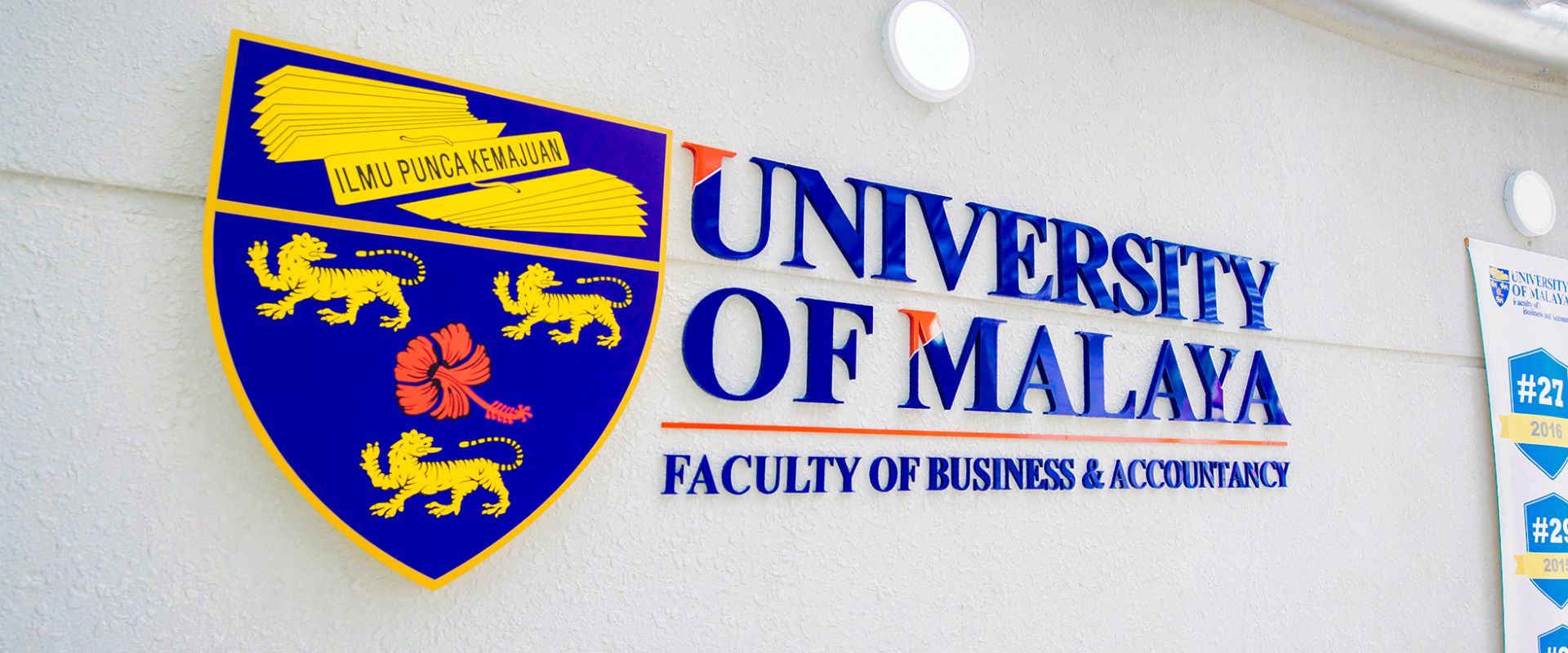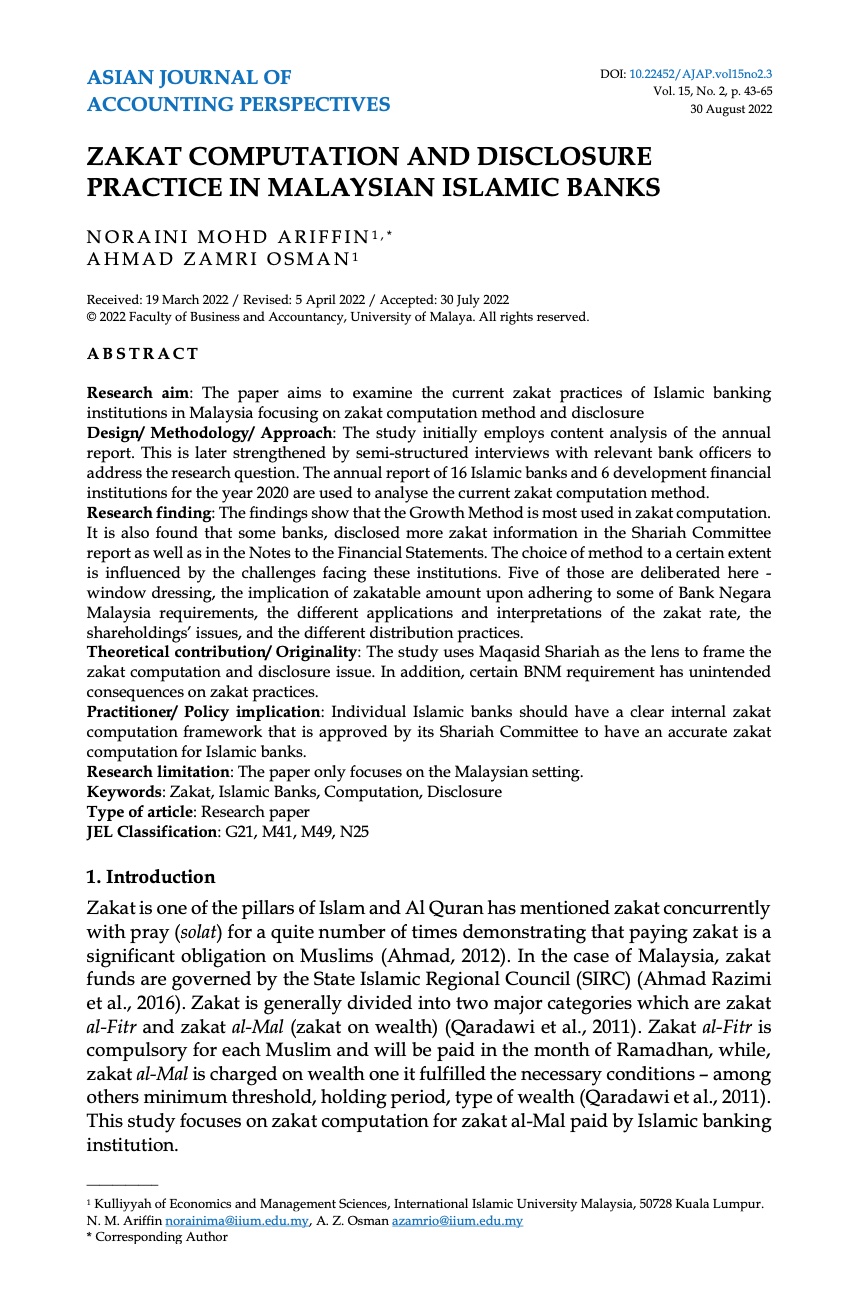Zakat Computation and Disclosure Practice in Malaysian Islamic Banks
Main Article Content
Abstract
Research aim: The paper aims to examine the current zakat practices of Islamic banking institutions in Malaysia focusing on zakat computation method and disclosure
Design/ Methodology/ Approach: The study initially employs content analysis of the annual report. This is later strengthened by semi-structured interviews with relevant bank officers to address the research question. The annual report of 16 Islamic banks and 6 development financial institutions for the year 2020 are used to analyse the current zakat computation method.
Research finding: The findings show that the Growth Method is most used in zakat computation. It is also found that some banks, disclosed more zakat information in the Shariah Committee report as well as in the Notes to the Financial Statements. The choice of method to a certain extent is influenced by the challenges facing these institutions. Five of those are deliberated here - window dressing, the implication of zakatable amount upon adhering to some of Bank Negara Malaysia requirements, the different applications and interpretations of the zakat rate, the shareholdings’ issues, and the different distribution practices.
Theoretical contribution/ Originality: The study uses Maqasid Shariah as the lens to frame the zakat computation and disclosure issue. In addition, certain BNM requirement has unintended consequences on zakat practices.
Practitioner/ Policy implication: Individual Islamic banks should have a clear internal zakat computation framework that is approved by its Shariah Committee to have an accurate zakat computation for Islamic banks.
Research limitation: The paper only focuses on the Malaysian setting.
Keywords: Zakat, Islamic Banks, Computation, Disclosure
Type of article: Research paper
JEL Classification: G21, M41, M49, N25
Downloads
Article Details
License
The Asian Journal of Accounting Perspectives (AJAP) articles are published under a licence equivalent to the Creative Commons Attribution-NonCommercial-NoDerivs License (CC BY-NC-ND). The licence allows users to copy, distribute, and transmit an article as long as the author is attributed. The article is not used for commercial purposes. The work is not modified or adapted in any way.
Copyright
Authors are required to sign the Exclusive License to Publish agreement upon publication in the AJAP. The agreement grants the Publisher (Faculty of Business and Accountancy, Universiti Malaya) to publish and disseminate the articles.
Open Access
Articles published in the AJAP are digital, online, free of charge, and free of most copyright and licensing restrictions.
Article Processing Charge
Articles publish in AJAP is free submission, production and publication charges. However, all accepted articles are required for language editing. The AJAP officially appointed and outsourced proofreader will conduct this process, and the authors will cover the cost. AJAP does not profit from this process and transaction.
References
AAOIFI. (1998). Financial Accounting Standard No. (9) Zakah.
AAOIFI. (2008). Shari’ah Standard No. (35) Zakah.
AAOIFI. (2021). FAS 39: Financial reporting for Zakah.
Abdullah, W. A. W., Percy, M., & Stewart, J. (2013). Shari’ah disclosures in Malaysian and Indonesian Islamic banks: The Shari’ah governance system. Journal of Islamic Accounting and Business Research.
Abu Ubayd al-Qasim, bin S., & Nyazee, I. A. (2005). The book of revenue : Kitab Al-Amwal. Garnet Publishing.
Adwamwafa, S. M. G. W. S. (2006). Kajian Perbandingan Syarat-syarat Penaksiran Zakat Perniagaan dengan FAS 9 AAOIFI. In Zakat: pensyariatan, perekonomian, dan perundangan. Penerbit Universiti Kebangsaan Malaysia.
Agarwal, V., Gay, G. D., & Ling, L. (2014). Window Dressing in Mutual Funds. The Review of Financial Studies, 27(11), 3133–3170. https://doi.org/10.1093/rfs/hhu045
Ahmad Razimi, M. S., Romle, A. R., & Muhamad Erdris, M. F. (2016). Zakat management in Malaysia: A review. American-Eurasian Journal of Scientific Research, 11(6), 453–457.
Ahmad, W. A. (2012, April 4). Obliging To zakat Payments. The Star Online.
Allen, L., & Saunders, A. (1992). Bank window dressing: Theory and evidence. Journal of Banking & Finance, 16(3), 585–623. https://doi.org/10.1016/0378-4266(92)90046-3
Badarulzaman, M. H., Azhar, A., & Ismail, C. T. (2016). Zakat Practice in Islamic Banking Institution: A Legal Horizon. Journal of Human Development and Communication, 5, 63–78.
Bakar, F. A., & Yusof, M. M. (2020). Stakeholder Management in Designing CSR Activities: The Case of Bank Islam. Journal of Business Management and Accounting, 6(1), 141–154.
Bakar, N. B. A. (2007). A zakat accounting standard (ZAS) for Malaysian companies. The American Journal of Islamic Social Sciences, 24(August), 74–92. https://doi.org/10.4135/9781446249215
Bank Negara Malaysia. (2019). Bank Negara Malaysia. http://www.bnm.gov.my/index.php?ch=en_about&pg=en_intro&ac=641&lang=en
Cai, J., García-Herrero, A., Li, F., & Le, X. (2019). The regulatory arbitrage and window dressing in shadow banking: the example of Chinese wealth management product. Economic and Political Studies, 7(3), 314–336. https://doi.org/10.1080/20954816.2019.1633825
Coe, K., & Scacco, J. M. (2017). Content analysis, quantitative. The International Encyclopedia of Communication Research Methods, 1–11.
Dechow, P. M., & Shakespear, C. (2009). Do Managers Time Securitization Transactions to Obtain Accounting Benefits? The Accounting Review, 84(1), 99–132. https://doi.org/10.2308/accr.2009.84.1.99
Gray, R., Kouhy, R., & Lavers, S. (1995). Corporate social and environmental reporting: a review of the literature and a longitudinal study of UK disclosure. Accounting, Auditing & Accountability Journal.
Griffiths, M. D., & Winters, D. B. (2005). The Turn of the Year in Money Markets: Tests of the Risk‐Shifting Window Dressing and Preferred Habitat Hypotheses. The Journal of Business, 78(4), 1337–1364. https://doi.org/10.1086/430862
Hackston, D., & Milne, M. J. (1996). Some determinants of social and environmental disclosures in New Zealand companies. Accounting, Auditing & Accountability Journal.
Haniffa, R., & Hudaib, M. (2007). Exploring the Ethical Identity of Islamic Banks via Communication in Annual Reports. Journal of Business Ethics, 76(1), 97–116. https://doi.org/10.1007/s10551-006-9272-5
Hasan, A. (2018). Zakat on Legal Entities (Shakhsiyyah I’Tibariyyah): A Shari’ah Analysis. Al-Shajarah: Journal of the International Institute of Islamic Thought and Civilization (ISTAC), 255–282.
Ibrahim, A., Abdullah, A. A., Kadir, M. R. B. A., & Adwamwafa, S. M. G. W. S. (2012). Assessing financial reporting on adopting business zakat guidelines on Malaysian Government Linked Companies. International Journal of Business and Social Science, 3(24).
Ingram, R. W., & Frazier, K. B. (1980). Environmental performance and corporate disclosure. Journal of Accounting Research, 614–622.
JAWHAR. (2010). Manual Pengurusan Zakat Perbankan.
Jusoh, W., & Ibrahim, U. (2017). Corporate social responsibility of Islamic banks in Malaysia: arising issues. Islamic Economic Studies, 25(Special Issue), 155–172.
Kasri, R. A. (2016). Maqasid al-Shariah and Performance of Zakah Institutions (Special Feature: New Waves in Islamic Economics: Renovation of the Traditional Economic Institutions (Waqf and Zakat) and Reconsidering Early Generations). イスラーム世界研究, 9, 19–41.
Krippendorff, K. (2018). Content analysis: An introduction to its methodology. Sage publications.
Maali, B., Casson, P., & Napier, C. (2006). Social reporting by Islamic banks. Abacus, 42(2), 266–289.
Mahmood M.Sanusi. (2004). Concept-of-legal-entity.doc. CRITICAL ISSUES ON ISLAMIC BANKING, FINANCE & TAKAFUL. https://view.officeapps.live.com/op/view.aspx?src=http%3A%2F%2Fwww.iefpedia.com%2Fenglish%2Fwp-content%2Fuploads%2F2009%2F11%2FConcept-of-legal-entity.doc&wdOrigin=BROWSELINK
Marsidi, A., Annuar, H. A., & Abdul Rahman, A. R. (2018). The impact of corporate governance on the financial, governance and social disclosure at Islamic banks in Malaysia. Journal of Islamic Finance, 176(6217), 1–17.
MASB. (2006). Techinal release on Accounting for Zakat on Business.
Milne, M. J., & Adler, R. W. (1999). Exploring the reliability of social and environmental disclosures content analysis. Accounting, Auditing & Accountability Journal.
Mohammad, H. S., Bujang, I., & Abd Hakim, T. (2015). The relationship between Shari’ah Supervisory Board and Zakat disclosure among Islamic banks in Malaysia.
Mosaid, F., & Bouti, R. (2012). Relationship between Corporate Social Responsibility and Financial Performance in Islamic Banking. Research Journal of Finance and Accounting, 3(10), 93–103.
Neuendorf, K. A. (2017). The content analysis guidebook. sage.
Noor, A. M., & Haron, M. N. (2013). Imposing Zakāt on Legal Entities and its Applications in Islamic Financial Institutions. Arab Law Quarterly, 27(1), 71–86.
Obid, S. N. S., & Hajj, A. F. (2011). Bank ethical disclosure level: Malaysian Islamics bank. Asia Pacific Journal of Accounting and Finance, 1(2), 199–210.
Osman, A.-Z. (n.d.). Zakat Accounting: Principles and Practices. IIIT.
Qaradawi, Y., Kahf, M., & Siddiqui, I. (2011). Fiqh al-Zakah : a comprehensive study of Zakah regulations and philosophy in the light of the Quran and Sunna. Islamic Book Trust.
Samad, A. K., & Said, R. (2016). Zakat Disclosure by Malaysian Banks. International Business Management, 10(20), 4737–4742.
Unerman, J. (2000). Methodological issues‐Reflections on quantification in corporate social reporting content analysis. Accounting, Auditing & Accountability Journal.
Weber, R. P. (1990). Basic content analysis (Issue 49). Sage.
Zahid, A. (2013). Corporate Personality from an Islamic Perspective. Arab Law Quarterly, 27(2), 125–150. https://doi.org/https://doi.org/10.1163/15730255-12341252

